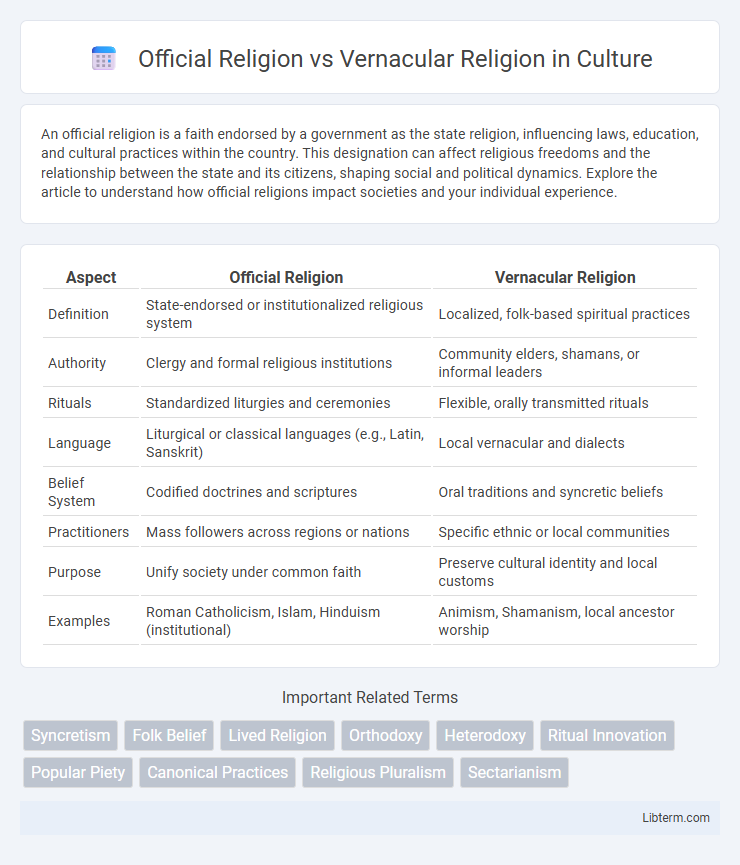An official religion is a faith endorsed by a government as the state religion, influencing laws, education, and cultural practices within the country. This designation can affect religious freedoms and the relationship between the state and its citizens, shaping social and political dynamics. Explore the article to understand how official religions impact societies and your individual experience.
Table of Comparison
| Aspect | Official Religion | Vernacular Religion |
|---|---|---|
| Definition | State-endorsed or institutionalized religious system | Localized, folk-based spiritual practices |
| Authority | Clergy and formal religious institutions | Community elders, shamans, or informal leaders |
| Rituals | Standardized liturgies and ceremonies | Flexible, orally transmitted rituals |
| Language | Liturgical or classical languages (e.g., Latin, Sanskrit) | Local vernacular and dialects |
| Belief System | Codified doctrines and scriptures | Oral traditions and syncretic beliefs |
| Practitioners | Mass followers across regions or nations | Specific ethnic or local communities |
| Purpose | Unify society under common faith | Preserve cultural identity and local customs |
| Examples | Roman Catholicism, Islam, Hinduism (institutional) | Animism, Shamanism, local ancestor worship |
Defining Official Religion and Vernacular Religion
Official religion refers to the organized, institutionalized system of beliefs, practices, and rituals endorsed by a governing authority or religious hierarchy, often codified in sacred texts and maintained through formal clergy. Vernacular religion encompasses the localized, everyday religious expressions and practices of laypeople, shaped by cultural traditions, personal experiences, and community interpretations rather than official doctrine. The distinction hinges on institutional authority and standardized theology versus grassroots, lived religious experiences and adaptations.
Historical Origins and Development
Official religion often originates from state sponsorship or centralized institutions, evolving through formal doctrines and codified rituals established by religious authorities. Vernacular religion emerges organically within local communities, reflecting indigenous beliefs, practices, and oral traditions passed down through generations without standardized texts. Historical development shows official religions frequently absorb or suppress vernacular elements, while vernacular religions adapt and persist through cultural continuity and grassroots spiritual expression.
Authority and Institutional Structures
Official religion typically operates under centralized authority with formal institutional structures such as clergy, doctrine, and hierarchical governance that enforce standardized beliefs and rituals. Vernacular religion thrives through localized practices and oral traditions, often lacking rigid institutional frameworks, relying instead on community leaders and personal spiritual experiences. The contrast lies in official religion's codified regulations versus vernacular religion's adaptive, decentralized authority embedded in everyday cultural contexts.
Rituals: Prescribed vs Local Practices
Official religion rituals are typically standardized, documented, and performed according to authoritative scriptures or doctrine, ensuring uniformity across all adherents. Vernacular religion rituals, by contrast, emphasize localized, community-based practices that evolve organically and often integrate pre-existing cultural traditions. These local practices highlight adaptability and personal meaning, reflecting the diverse ways individuals experience and express spirituality beyond formal religious prescriptions.
Transmission of Religious Knowledge
Official religion relies on structured institutions, sacred texts, and formal clergy to transmit religious knowledge with standardized doctrines and rituals, ensuring consistency across adherents. Vernacular religion, however, emphasizes oral traditions, local customs, and community practices, transmitting beliefs informally through storytelling, folk rituals, and personal experience. This grassroots transmission allows for adaptation and variation in religious knowledge, reflecting regional cultural contexts and individual interpretations.
Role of Language in Religious Expression
The role of language in religious expression distinctly separates official religion from vernacular religion, as official religion typically employs sacred, classical, or liturgical languages that preserve doctrinal purity and ritual uniformity. Vernacular religion uses the everyday language of the local population, making religious beliefs and practices more accessible and relatable, thus fostering communal participation and personal spirituality. This linguistic difference shapes how religious knowledge is transmitted, experienced, and adapted within diverse cultural contexts.
Power Dynamics and Social Control
Official religion often serves as a tool for power consolidation, legitimizing ruling authorities and enforcing social hierarchies through codified doctrines and rituals. Vernacular religion, expressed through localized beliefs and practices, provides communities with alternative frameworks for meaning and resistance, sometimes challenging official narratives. The tension between these forms reflects ongoing struggles over social control, identity, and the distribution of cultural capital within societies.
Adaptation and Resistance Within Communities
Official religion often imposes standardized doctrines and rituals that require communities to adapt their traditional beliefs and practices, sometimes leading to cultural shifts or syncretism. Vernacular religion embodies localized, grassroots expressions of faith that resist formal institutional control by preserving indigenous customs and personalized spirituality. This dynamic between adaptation and resistance shapes how communities negotiate identity, continuity, and transformation within religious landscapes.
Case Studies: Religion in Diverse Cultures
Official religion often represents state-sanctioned belief systems that shape national identity, such as Catholicism in Mexico or Islam in Saudi Arabia, while vernacular religion embodies localized practices and beliefs unique to community traditions, seen in African indigenous spiritualities or folk Hinduism in India. Case studies highlight that vernacular religions integrate everyday cultural elements, oral traditions, and syncretic rituals, creating distinct religious expressions that coexist with or subtly resist official religious frameworks. These diverse cultural contexts reveal the dynamic interplay between institutional authority and grassroots religiosity, influencing social cohesion and identity formation.
Implications for Modern Religious Identity
Official religion, often codified through centralized institutions and canonical texts, shapes religious identity by enforcing standardized beliefs and practices that influence social and political structures. Vernacular religion emphasizes localized, personalized expressions of faith that adapt to cultural contexts, fostering diverse interpretations and practices among adherents. The tension between official and vernacular religion impacts modern religious identity by creating dynamic negotiations between institutional authority and individual spiritual experience, contributing to pluralism and evolving beliefs within contemporary faith communities.
Official Religion Infographic

 libterm.com
libterm.com